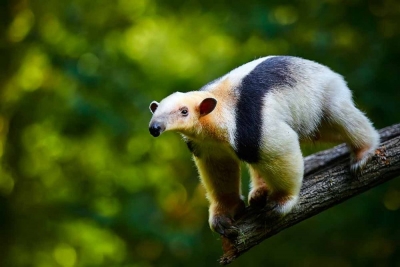
Tamanduas, also called lesser anteaters, are smaller than their giant anteater relatives. They live in a variety of habitats – including tropical forests, scrub grasslands and wetlands – and are often found near streams and rivers.
A tamandua’s sticky tongue is the perfect bug catcher. At nearly 16 inches long, it can easily scour the narrow tunnels of termite mounds and ant colonies. All anteaters, including tamanduas, belong to the suborder Vermilingua, meaning “worm-tongue.”
They can eat about 9,000 insects a day. Tamanduas tear into logs with their strong claws and use their tongues to slurp up insects. Though they are anteaters, they also chow down on termites, mealworms, bees (and their honey), and even the occasional fruit. Tamanduas’ mouths only open to about the width of a pencil eraser and they have no teeth, so a muscular gizzard in their stomach helps them digest their meals. Tamanduas are arboreal, meaning they spend most of their time in trees. Their prehensile tails can grasp onto branches, helping them maintain balance as they climb high above the ground. The underside of a tamandua’s tail has no fur, which helps it grip branches more securely.
Tamanduas are amazing animals, but they require specialized care and should never be kept as pets. It is against the law to keep a tamandua without a license in some areas, and tamanduas often die while being illegally transported for the pet trade.
Tamanduas are hunted by harpy eagles and big cats, such as ocelots and jaguars, but they won’t go down without a fight. How do tamanduas protect themselves? Big claws and muscular forearms help them fend off attacks. They also deter predators by hissing and releasing a stinky odor from their anal glands.
Tamanduas have huge claws that prevent them from walking flat-footed on the ground, so they walk on the sides of their paws instead. Though tamanduas tend to stick to dry land, they have occasionally been known to swim.
Credit : Smithsonian voices
Picture Credit : Google




